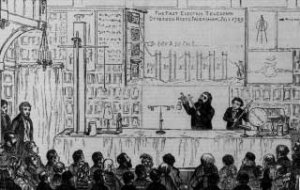The history and present state of electricity
Joseph PRIESTLEY, The History and Present State of Electricity. With Original Experiments. Vol.I. The Discoveries of Mr. Grey (Gray).
The Experiments and Discoveries of Mr. Stephen Grey, which were made prior to those of Monsieur du Fay, and which bring the History of Electricity to the Year 1733.
BEFORE the year 1728, Mr. Stephen Grey had often observed, in electrical experiments made with a glass tube and a down feather tied to the end of a small stick, that, after its fibres had been drawn toward the tube, they would, upon the tube’s being withdrawn, cling to the stick, as if it had been an electric body, or as if there had been some electricity communicated to the stick, or to the feather. This put him upon thinking, whether, if the feather were drawn through his fingers, it might not produce the same effect, by acquiring some degree of electricity. This experiment succeeded accordingly, upon his first trial; the small downy fibres of the feather being attracted by his finger, when held near it; and sometimes the upper part of the feather with its stem would be attracted also.
IT will be obvious to every electrician, that the success of his experiment depended upon other principles, than those to which he had a view in making it. Proceeding, however, in the same manner, he found the following substances to be all electric ; hair, silk, linen woolen, paper, leather, wood, parchment; and ox gut in which leaf gold had been beaten. He made all these substances very warm, and some of them quite hot before he rubbed them.
HE found light emitted in the dark by the silk and the linen, but more especially by a piece of white pressing paper. Not only did this substance, when made as hot as his fingers were held near it, a light issued from them also, attended with a crackling noise, like that produced by glass tube, though not at so great a distance from the fingers [1].
THE preceding experiments bring us to the eve of a very considerable discovery in electricity, viz, the communication of that power from native electrics, to bodies, in which it is not capable of being excited; and also to a more accurate distinction of electrics from non-electrics. I shall relate the manner in which these important discoveries were made pretty fully, but, at the same time, as succinctly as possible.
IN the same manner in which silk was found to be a non-conductor, it is probable that, about the same time, hair, resin, glass, and perhaps some other electric substances, were found to have the same property, though the discovery be nowhere particularly mentioned : for we shall presently find Mr. Grey making use of them, to insulate the bodies which he electrified.
AFTER this, Mr. Grey and his friends amused themselves with trying how large surfaces might be impregnated with the electric effluvia; electrifying a large map, table cloth, &c. They also carried the electric virtue several ways at the same time, and to a considerable distance each way.
THE magnetic effluvia, they found, did not in the least interfere with the electric ; for when they had electrified the load stone, with a key hanging to it, they both attracted leaf brass like other substances.
SOME time after this, Mr. Wheeler, in the absence of Mr. Grey, electrified a red-hot poker, and found the attraction to be the same as when it was cold. He also suspended a live chicken upon the tube by the legs, and found the breast of it strongly electrical †.
IN August, 1729, Mr. Grey advanced one step farther in his electrical operations. He found that he could convey the electric virtue from the tube to the line of communication without touching it, and that holding the excited tube near was sufficient. Repeating his former experiments with this variation, in conjunction with Mr. Wheeler, and among others, carrying the electric virtue several ways at the same time without touching the line, they always observed, that the attraction was strongest at the place which was most remote from the tube; a fact which they might have observed, if they had attended to it, in their former experiments [2].
SOME time in the same month, Mr. Wheeler and Mr. Grey in conjunction made some experiments, in order to try whether the electric attraction was in proportion to the quantity of matter in bodies ; and with this view they electrified a solid cube of oak, and another of the same dimension which was hollow ; but they could not perceive any difference in their attractive power ; though it was Mr. Grey’s opinion, that the electric effluvia passed through all the parts of the solid cube †.
ON the 13th of August in the same year, Mr. Grey made another improvement in his electrical apparatus, by finding that he could electrify a rod, as well as a thread, without inserting any part of it into his excited tube. He took a large pole twenty-seven feet long, two inches and one half in diameter at one end, and one inch and one half at the other. It was a sort of wood which is called horse-beach, and had its rind on. This pole he suspended horizontally by hair lines, and at the small end of the pole he hung a cork, by means of a packthread about one foot long, and put a small leaden ball upon the cork, to keep the packthread extended. Then the leaf brass being put under the cork, the tube rubbed, and held near the larger end of the pole, the cork ball at the opposite end attracted the leaf brass strongly, to the height of an inch or more. Mr. Grey also observed that though the leaf brass was attracted by any part of the pole, it was not near so strongly as by the cork [3].
ABOUT the beginning of September, Mr. Grey made experiments, to shew that the electric effluvia might be carried in a circle, as well as along lines, and be communicated from one circle to another ; and also that it might be done whether the circles were vertical, or horizontal.
ABOUT the latter end of autumn, or the beginning of winter 1729, Mr. Grey resumed his inquiries after other electrical bodies, and found many more to have the same property, but he mentions only the dry leaves of several trees; from whence he concluded, that the leaves of all vegetables had that attractive virtue [4].
WE are now advanced to a new scene of Mr. Grey’s electrical experiments, viz. upon fluids, and upon animal bodies. Having no other method of trying whether any substances could have the electric virtue communicated to them, but by making them raise light bodies placed upon a stand under them, it may easily be imagined, that he could not well contrive to put a fluid body into that situation. The only thing that Mr. Grey could do in this way, was to make use of a bubble, in which form a fluid is capable of being held in a state of suspension. Accordingly on March 23d and 25th, 1730, he dissolved soap in Thames water, and suspending a tobacco pipe, he blew a bubble at the head of it ; and, bringing the excited tube near the small end, he found the bubble to attract leaf brass to the height of two, and of four inches †.
APRIL the 8th, 1730, Mr. Grey suspended a boy on hair lines in a horizontal position, just as all electricians had, before, been used to suspend their hempen lines of communication, and their wooden rods ; then, bringing the excited tube near his feet, he found that the leaf brass was attracted by his head with much vigour, so as to rise to the height of eight, and sometimes of ten inches. When the leaf brass was put under his feet, and the tube brought near his head, the attraction was small; and when the leaf brass was brought under his head, and the tube held over it, there was no attraction at all.
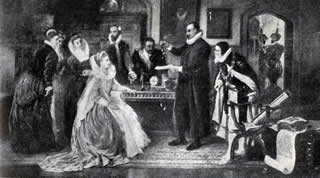
- Electricity Mid
- [click on the picture to enlarge it]
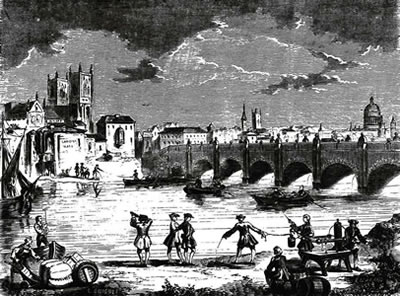
- Crossing the river Thames
- Autorisation accordée par EDF
[click on the picture to enlarge it]
Illustrations:
A lecture at the Charterhouse on discoveries in electricity by Stephen Gray. The diagram above the speaker shows the first electric telegraph at Otterden House, Faversham, of July 1729:
Gray and a friend, Jean Desaguliers, conducted experiments which showed that objects such as cork, as far as eight or nine hundred feet away, could be electrified by connecting them to the glass tube with wires or hempen string. They found material such as silk would not convey electricity. They discovered distant objects could not be electrified if the transmission line made contact with earth. The line for transmission was suspended by silk threads to prevent contact with the ground. It was found that metal objects held in the hand and rubbed showed no signs of electrification. However, when mounted on a non-conductor, they became electrified. Gray realized that somehow the earth was responsible for conducting electrical charge away from the body. After this realization Gray found he could electrify any material on earth by friction.
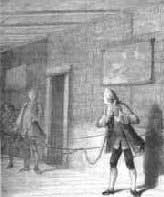
- Gray
He even went as far as to suspend pupils of the house by cords and electrified them, sometimes even drawing sparks from the human body. The figure shows that the electric force of a rubbed glass could be sent, throught a wire, to the body of a person.
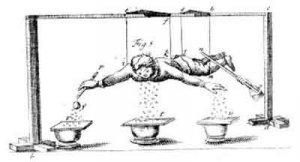
- Suspended pupil
- [click on the picture to enlarge it]
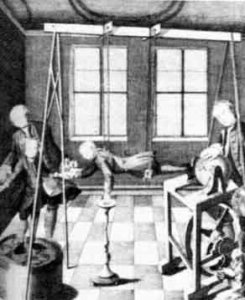
- Suspended pupil
- [click on the picture to enlarge it]
From all these experiments, it became clear that electrification is a surface effect; that the electric “virtue” or “fluid” would move freely along some materials-named, by Desaguliers, “non-electrics” or “conductors” - from one body to another. The earth, the human body, metals, moisture are immediately recognized as conductors. Materials which do not conduct electricity came to be called nonconductors or insulators. A metal rod or sphere when held in the hand and rubbed with fur shows no sign of electrification, but when mounted on a nonconductor, the metal is readily electrified. The electrical charge is no longer conducted away to be shared with the huge object which is the earth. When this was realized, it was found that practically any material can be electrified by friction. Water is found to be a conductor. It renders insulators conducting when the surfaces are wet or moist. This makes understandable the rapid loss of charge by electrified bodies on humid days.
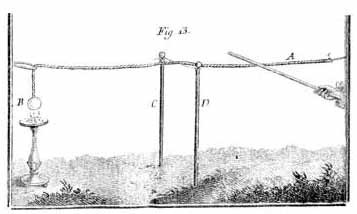
- Electrical conductors
So Gray is credited with finding that electrical conductors must be insulated and that insulators were not conductors and that a charge could be induced in a previously non-electrified body. He established electricity as a current showing it would travel over a conductor. Gray found water to be a conductor which rendered insulators into conductors when their surfaces were wetted. This concept helps us to understand the rapid loss of charges on humid days by electrified bodies. He sent many of his papers to the Royal Society and was elected a fellow. Gray’s most important work, published in 1732, announced the discovery of electrical induction and the distinction between conductors and insulators.
Gray hypothesized that electricity flows everywhere, and he paved the way for more than a generation of “electricians” - wandering scientists who made their living by demonstrating the electric current using Leyden jars. Electricians typically killed birds and other small animals with electric shock and passed electric current across rivers and lakes.
He was awarded the Copley Medal in 1731 (the first award) and again in 1732 for his research on electricity. In his later years Gray was frequently resident with John Godfrey, Esq., (who had also been, note, a patron of John Harris) of Norton Court, Kent, and with the Rev. Granville Wheler, a prosperous cleric, both of whom aided his experiments in electricity and gave him financial support. He continued his research until upon his death bed 15th February 1736) where he tried to describe to his doctor the work he still needed to complete.
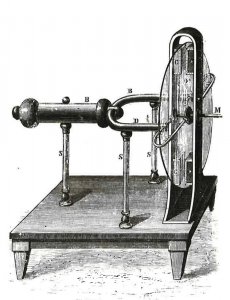
- Ramsden’s electrical machine (1768)
- [click on the picture to enlarge it]
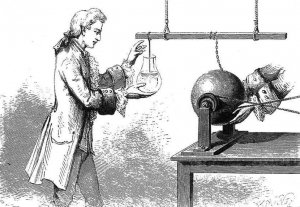
- The Leyde Bottle
- [click on the picture to enlarge it]
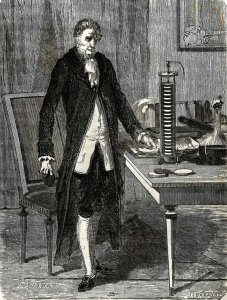
- In 1799, Volta built the first electrical battery
- [click on the picture to enlarge it]
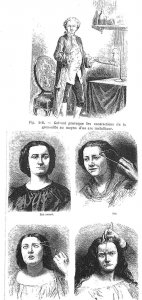
- “to be galvanised”
- [click on the picture to enlarge it]
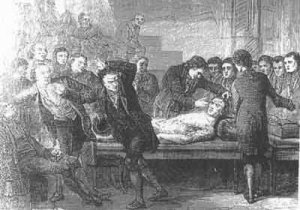
- Galvanised corpses
- [click on the picture to enlarge it]

- Mesmer’s bucket



